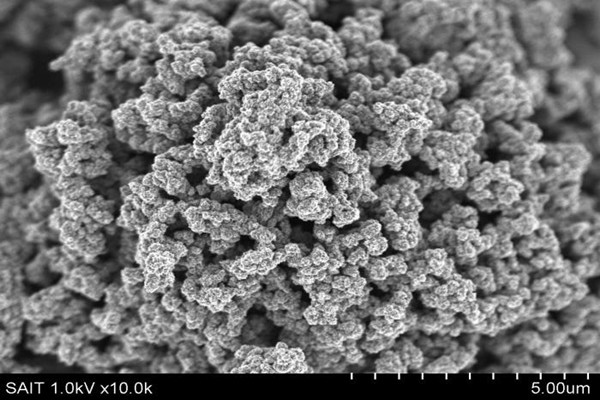Research team from Samsung Advanced Institute of Technology (SAIT) has developed ‘graphene ball’, which is a battery material that improves charging capacity by 45% and charging speed by 5 times more than current lithium-ion batteries. It reduces time to completely charge a battery to 12 minutes when it used to take about an hour and it can be applied to electric vehicles as it is safe in high temperature. It is seen as a possible next-generation technology that will surpass current battery technologies.
SAIT announced on the 27th that it has developed graphene ball.
Research team led by Son In-hyeok and Doo Seok-kwanng investigated a mechanism that combines graphene in large into a 3D structure like a popcorn by using cost-effective silica while it was looking for a way to apply graphene, which has high conductivity and solidity, onto a battery. If this ‘graphene ball’ is used as anodic protective film and cathodic material for lithium-ion batteries, it will improve charging capacity and reduce charging time. It is still safe in high temperature even when charging speed becomes faster. If graphene ball is used, stability can be maintained until 60 degrees, which is the standard temperature requested for electric vehicle batteries.
After lithium-ion battery was first commercialized in 1991, its markets have been growing continuously as its application has expanded towards mobile devices and electric vehicles. However improvement in its performance has faced limitations. It is not easy to increase battery capacity and it still takes at least an hour to completely charge a battery. Many various attempts are being made to apply new innovative materials, and graphene is seen as the leading candidate out of possible next-generation materials.

SAIT applied for two patents in the U.S. and South Korea for its technologies regarding ‘graphene ball’ and it is planning to perform follow-up researches continuously until its technology is commercialized.
“While this research is able to combine many multifunctional high crystalline graphene materials in large and inexpensively, it also greatly improved many characteristics of lithium-ion batter.” said Son In-hyeok who is the lead author for a thesis on this technology. “We are going to continue to develop secondary battery-related technologies according to expansion of mobile device and electric vehicle markets that have recently started growing rapidly.”
Samsung SDI and a research team led by Professor Choi Jang-wook of Seoul National University Chemical Biological Engineering Department co-participated in this research. Result from this research was published under the subject ‘Implementation of Fast Charging and High-Capacity Lithium-Ion Batteries Utilizing Graphene Ball’ online through a scientific journal called ‘Nature Communications’.
Graphene: Graphene is thin carbon atom layer peeled off from graphite. It is receiving spotlight as a new material for battery and display industries due to its high physical and chemical stabilities. It is seen as a dream material for rapid charging as Its electricity flow is 100 times better than copper and it can move electrons 140 times faster than silicon.
Staff Reporter Kwon, Keonho | wingh1@etnews.com